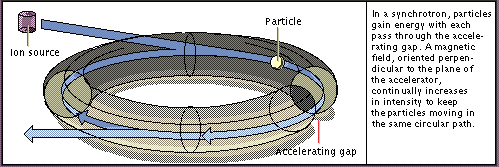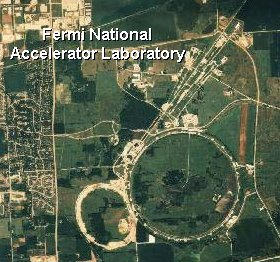
Of the two main types of particle accelerators, the circular accelerators are able to accelerate particles to higher energies than the linear accelerators. Basically circular accelerators are linear accelerators in the shape of a circle. Very powerful magnets are used to deflect the charged particles into circular paths. There are several types of circular accelerators.
One type of circular accelerator is the cyclotron, in which cylindrical magnets bend the particle trajectories into a circular path. The magnets produce a circular magnetic field. An oscillating voltage creates an electric field across the gap to accelerate the particles each time around. As the particles moved faster, the radius of the their circular path becomes bigger until they hit the target on the outermost circle. However, Einstein's theory of relativity states that the mass of a particle increases as its velocity approaches the speed of light; hence, very energetic, high-velocity particles will have greater mass and thus less acceleration. Because of this concept, cyclotrons are only a to produce very low levels of energy, relatively speaking. For protons, the maximum energy attainable with an ordinary cyclotron is about 10 MeV.

image courtesy of: http://encarta.msn.com/media_461530288_761557105_-1_1/Particle_Accelerators.html
Another type of circular accelerator is the synchrocyclotron, The synchrocyclotron is designed to compensate for the increase in the mass of a particle. the frequency of the oscillating electric field decreases to match the decreasing velocity of the protons.
Another type of circular accelerator is the synchrotron. The first synchrotron was built in 1952 at the Brookhaven National Laboratory was able to reach an energy of 3 GeV. In this device, a ring of magnets surrounds a doughnut-shaped vacuum tank. The magnetic field increases as the velocity of the particle increases,which allows the particles to move in a circular pattern instead of the increasing spiral of the cyclotron. because you now have a pretty much a circle with nothing in the center, you can make the synchrotron as large as you like. Particles must be injected into a synchrotron from another accelerator.

image courtesy of: http://encarta.msn.com/media_461530288_761557105_-1_1/Particle_Accelerators.html
The largest of the synchrotrons is the Tevatron at the Fermi National Accelerator Laboratory at Batavia, Ill. It was built in the 1970s, has a circumference of 4 miles (6km) and can reach energies of 2 TeV.

Aerial View of Fermi National Accelerator Laboratory
Image courtesy of: http://science.howstuffworks.com/atom-smasher2.htm